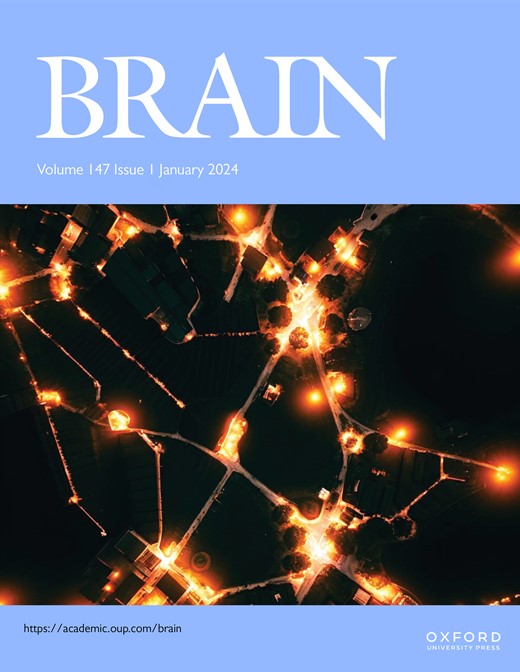Genotype-specific interferon signatures in amyotrophic lateral sclerosis relate to disease severity.
IF 11.7
1区 医学
Q1 CLINICAL NEUROLOGY
引用次数: 0
Abstract
Innate immune signaling pathways are hyperactivated in the central nervous system (CNS) of patients with Amyotrophic Lateral Sclerosis (ALS), as well as in preclinical models with diverse causative backgrounds including TDP-43, SOD1, and C9orf72 mutations. This raises an important question of whether these pathways are key pathogenic features of the disease, and whether therapeutic amelioration could be beneficial. Here, we systematically profile Type-I interferon (IFN)-stimulated gene (ISG) expression signatures using a non-biased approach in CNS tissue from a cohort of 36 individuals with ALS, including sporadic ALS (sALS; n=18), genetic ALS caused by (i) a C9orf72 hexanucleotide repeat expansion (C9-ALS; n=11), and (ii) a SOD1 mutation (SOD1-ALS; n=5), alongside age- and sex-matched individuals who died of a non-neurological cause (n=12). Using this deeply phenotyped cohort we have implemented targeted transcriptomic analysis and immunohistochemistry to interrogate the nature and extent of the activation of the Type-I IFN response in patients. We determined disease and genotype specific IFN signatures that correlate with clinical phenotype. Correlation analysis linked six ISGs with aggressive disease progression, as indicated by negative correlation with age at death in ALS patients. Notably, significant upregulation of ISGs was observed in C9-ALS patients, with higher ISG expression correlating with shorter disease duration. Noting that our genotype and disease specific signatures correlated with metrics of disease progression, we explored the therapeutic potential of targeting this pathway in a mouse model of ALS. Treatment with an IFN pathway inhibitor reduced IFN response markers, delayed disease progression, including motor decline, and extended survival in ALS mice. We conclude that upregulation of gene expression in the Type-I IFN pathway represents a key pathological feature of ALS and that inhibiting this pathway may provide a promising therapeutic approach for treating ALS.肌萎缩性侧索硬化症基因型特异性干扰素特征与疾病严重程度相关。
肌萎缩性侧索硬化症(ALS)患者的中枢神经系统(CNS)先天免疫信号通路过度激活,在包括TDP-43、SOD1和C9orf72突变在内的多种病因背景的临床前模型中也是如此。这提出了一个重要的问题,即这些途径是否是该疾病的关键致病特征,以及治疗改善是否有益。在这里,我们系统地分析了来自36名ALS患者的中枢神经系统组织中i型干扰素(IFN)刺激基因(ISG)表达特征,使用无偏倚的方法,包括散发性ALS (sALS, n=18),由(i) C9orf72六核苷酸重复扩增(C9-ALS, n=11)和(ii) SOD1突变(SOD1-ALS, n=5)引起的遗传性ALS,以及年龄和性别匹配的非神经系统原因死亡的个体(n=12)。使用这个深度表型队列,我们已经实施了靶向转录组分析和免疫组织化学来询问患者i型IFN反应激活的性质和程度。我们确定了与临床表型相关的疾病和基因型特异性IFN特征。相关分析表明,6种isg与ALS患者的侵袭性疾病进展呈负相关,与死亡年龄呈负相关。值得注意的是,在C9-ALS患者中观察到ISG的显著上调,ISG的高表达与较短的病程相关。注意到我们的基因型和疾病特异性特征与疾病进展指标相关,我们在ALS小鼠模型中探索了靶向这一途径的治疗潜力。在ALS小鼠中,IFN通路抑制剂治疗可降低IFN反应标志物,延缓疾病进展,包括运动能力下降,并延长生存期。我们得出结论,i型IFN通路基因表达上调是ALS的一个关键病理特征,抑制该通路可能为治疗ALS提供一种有希望的治疗方法。
本文章由计算机程序翻译,如有差异,请以英文原文为准。
求助全文
约1分钟内获得全文
求助全文
来源期刊

Brain
医学-临床神经学
CiteScore
20.30
自引率
4.10%
发文量
458
审稿时长
3-6 weeks
期刊介绍:
Brain, a journal focused on clinical neurology and translational neuroscience, has been publishing landmark papers since 1878. The journal aims to expand its scope by including studies that shed light on disease mechanisms and conducting innovative clinical trials for brain disorders. With a wide range of topics covered, the Editorial Board represents the international readership and diverse coverage of the journal. Accepted articles are promptly posted online, typically within a few weeks of acceptance. As of 2022, Brain holds an impressive impact factor of 14.5, according to the Journal Citation Reports.
 求助内容:
求助内容: 应助结果提醒方式:
应助结果提醒方式:


